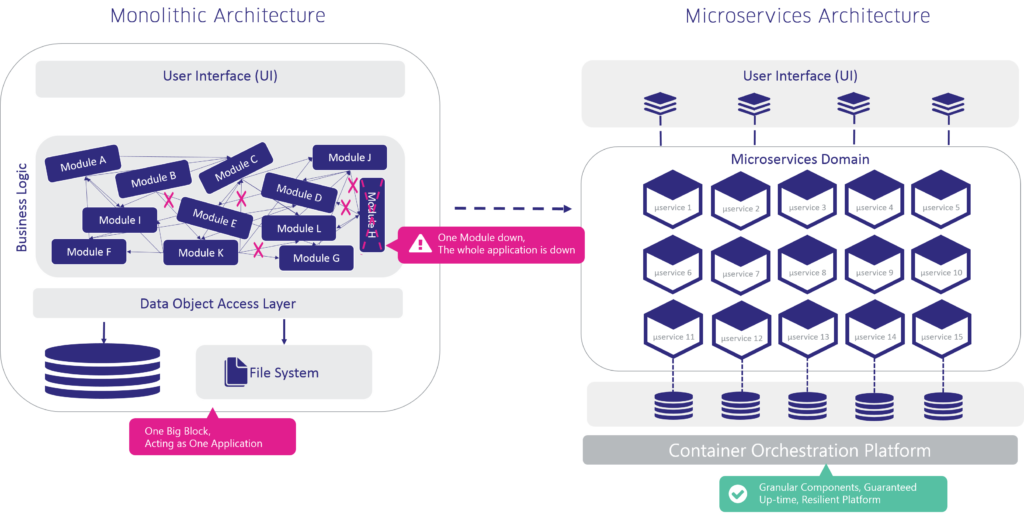
Benefits of Microservices for Your Business Agility
- Posted by Adham Jan
- On November 2, 2020
Is your software as responsive to business demands as it needs to be? Does it have scalability or is it a constant nightmare for your Development and Operations teams to maintain? Can it integrate with new devices, systems and add new features? If it doesn’t, maybe it’s time to consider transforming your systems. Let’s explore the benefits of microservices architecture.
Why Microservices Architecture?

Microservices architecture or microservices is a software development style where the software application is modular and created through independent components. These modules perform a given task and work independently, providing continuous delivery, even when another module is offline. The granularity of these modules is very small.
They are designed to handle one task, communicating with the other modules through a common APIs. The benefits of microservices at the DevOps level is, that they allow for continuous integration and fast delivery, even if the module is written in a different software language and allows scalability and simple integration with other modules. As a result, software development goes faster and is far more maintainable and scalable on the long run.
 |
Featured E-BookTime-To-Market Driven Disruption Starter Guide to Microservices and Business AgilityThis e-book brings you a holistic approach into beginning your microservices transformation journey. |
Benefits of Microservices Architecture
Microservices architecture allows for faster development and deployments since it simplifies the design. Each module is easily built, tested and deployed independently, thus giving your business increased agility and faster time to market.

Faster Deployments
Microservices architecture allows for faster development and deployments since it simplifies the design. Each module is easily built, tested and deployed independently, thus giving your business increased agility and faster time to market.
Scalability
Microservices architecture by design offers ease in scalability since the modules work independently and each has bounded context. The design is far more simple allowing fast adding of new features. With reliance on DevOps practices and test automation each module is tested independently and the whole system is tested in minutes automatically thus cutting down the time to build, test and release new features.
On the infrastructure level, each microservice is scaled and managed independently. You don’t need to scale the whole system in case of peak time and load. Only microservices under load are scaled. This is also done automatically with no human intervention with auto-scaling capabilities and self-healing.
Guaranteed up-time
With the right microservices architecture, it’s almost impossible for the whole system to go down. Since each microservice is built, deployed and managed independently and is totally isolated at runtime so the whole system can never go down.
In case a microservices crashes, it will impact only its functionality, the rest of the system will behave normally. Also microservices platforms like Kubernetes have high availability, load balancing and autoscaling capabilities that scales each microservice independently incase of high load and certain thresholds are reached.

No Vendor Lock
Microservices architecture and principles are based on open standards and backed up heavily by the open source community. Almost all commercial microservices platforms follow these open standards which makes it easy to migrate from them if needed. Also by design microservices have standard based APIs which makes it easy to extend and even use different programming languages and technologies.
Resilience & Robustness
With microservices architecture, your platforms are far more resilient and robust. In other words, Kubernetes or OpenShift Container platforms are monitoring and self-healing whenever the system is affected. Their orchestration capabilities can self-monitor and restart failed components. Self-healing extends from monitoring infrastructure, clusters to nodes and pods. Self-monitoring and healing ensures resilience for your applications and systems.
Dynamic Talent Pool
With microservices, it’s easier to onboard new team members as well as hiring software engineers with different coding backgrounds.
See How Sumerge Can Improve Your Systems with Microservices
At Sumerge, we understand your organization needs applications that provide continuous delivery that are still agile, scalable, and allow for continuous integration. We are experts at designing new microservices applications as well as redesigning old monolithic applications and code to fit a more agile architecture. We offer cost effective solutions to your needs.




